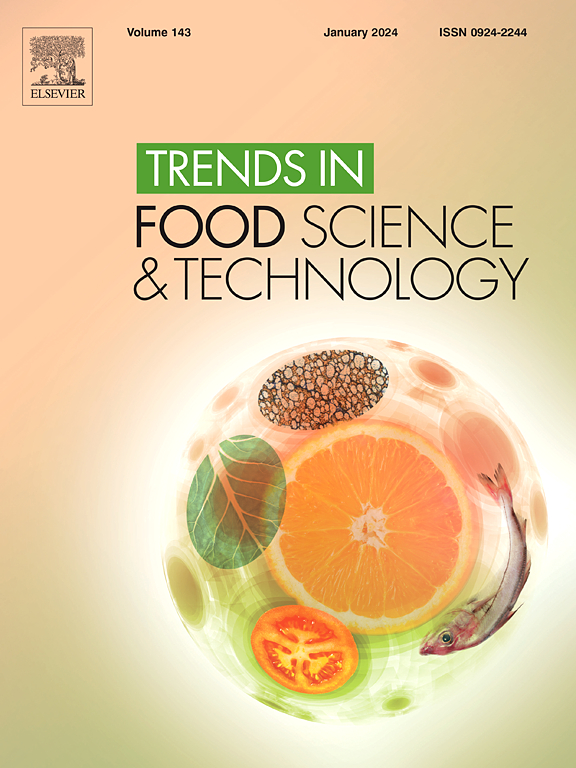Rethinking creatine fortification: Addressing nutritional gaps through food enrichment
IF 15.1
1区 农林科学
Q1 FOOD SCIENCE & TECHNOLOGY
引用次数: 0
Abstract
Creatine, a conditionally essential nutrient, plays a vital role in cellular energy metabolism, particularly during periods of high metabolic demand. Given that dietary creatine is primarily sourced from animal-based foods, individuals following vegetarian or vegan diets, as well as those with increased nutritional needs, may be at risk of inadequate creatine intake. Population-based studies indicate that up to 65.2 % of individuals consume creatine at suboptimal levels, which has been linked to adverse health outcomes, including increased risk of depression, a higher incidence of certain cancers, and greater likelihood of liver disease. This report examines the potential for creatine fortification within the framework of established nutrient fortification guidelines. Key principles of effective fortification—such as the selection of widely consumed food vehicles, maintenance of nutrient balance, stability, bioavailability, and safety—support creatine's viability as a fortificant. Dairy products, consumed by approximately 80 % of young children and 60 % of older adults, along with cereals, found in 70 % of American households, emerge as promising candidates for fortification. Additionally, creatine's chemical stability allows it to retain up to 100 % of its original concentration for 12 months, ensuring its integrity in fortified foods. Its nearly 100 % bioavailability further supports efficient absorption and utilization. Furthermore, creatine's strong safety profile, with tolerable intake levels of up to 5 g/day and no reported toxicity even at doses of 30 g/day over several years, reinforces its inclusion in public health strategies. While additional research is needed to refine optimal fortification levels and assess long-term safety, creatine fortification presents a promising intervention for addressing dietary deficiencies and improving population health outcomes.
重新思考肌酸强化:通过食物强化解决营养缺口
肌酸是一种条件必需营养素,在细胞能量代谢中起着至关重要的作用,特别是在高代谢需求时期。鉴于膳食肌酸主要来源于动物性食物,素食者或纯素食者以及那些营养需求增加的人可能面临肌酸摄入不足的风险。基于人群的研究表明,高达65.2%的人摄入的肌酸低于最佳水平,这与不利的健康结果有关,包括抑郁症风险增加、某些癌症发病率增加和患肝病的可能性增加。本报告探讨了在已建立的营养强化指南框架内肌酸强化的可能性。有效强化的关键原则——如选择广泛食用的食品,维持营养平衡、稳定性、生物利用度和安全性——支持肌酸作为强化剂的可行性。大约80%的幼儿和60%的老年人食用乳制品,以及70%的美国家庭中发现的谷物,成为有希望的强化产品。此外,肌酸的化学稳定性使其能够在12个月内保持100%的原始浓度,确保其在强化食品中的完整性。其近100%的生物利用度进一步支持有效的吸收和利用。此外,肌酸具有很强的安全性,可耐受的摄入量高达5克/天,即使在30克/天的剂量下,几年来也没有毒性报告,这加强了将其纳入公共卫生战略。虽然需要进一步的研究来完善最佳强化水平和评估长期安全性,但肌酸强化是解决饮食不足和改善人口健康结果的有希望的干预措施。
本文章由计算机程序翻译,如有差异,请以英文原文为准。
求助全文
约1分钟内获得全文
求助全文
来源期刊

Trends in Food Science & Technology
工程技术-食品科技
CiteScore
32.50
自引率
2.60%
发文量
322
审稿时长
37 days
期刊介绍:
Trends in Food Science & Technology is a prestigious international journal that specializes in peer-reviewed articles covering the latest advancements in technology, food science, and human nutrition. It serves as a bridge between specialized primary journals and general trade magazines, providing readable and scientifically rigorous reviews and commentaries on current research developments and their potential applications in the food industry.
Unlike traditional journals, Trends in Food Science & Technology does not publish original research papers. Instead, it focuses on critical and comprehensive reviews to offer valuable insights for professionals in the field. By bringing together cutting-edge research and industry applications, this journal plays a vital role in disseminating knowledge and facilitating advancements in the food science and technology sector.
 求助内容:
求助内容: 应助结果提醒方式:
应助结果提醒方式:


